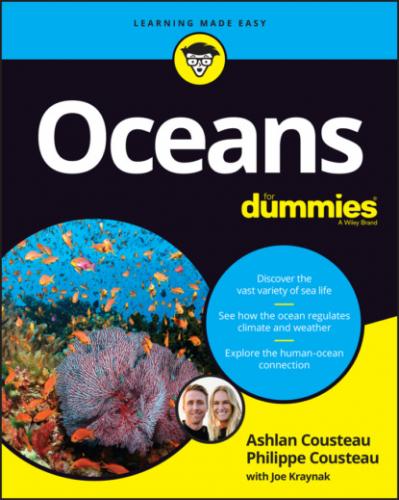Part 2
Finding Your Way Around
IN THIS PART …
Explore different ways to divide the ocean into zones based on depth, light, distance from shore, and other factors … and understand why we divide the ocean into zones.
Grasp the concept of marine ecosystems — biological “neighborhoods” where organisms have evolved over time in response to their interactions with their environment and with one another. (Well, now you’ve grasped it.)
Visit the most popular ocean ecosystems from mudflats, estuaries, and mangrove forests along the coasts to offshore kelp beds and coral reefs to ecosystems that form around hydrothermal vents and cold seeps in the deep ocean.
Explore the geophysics of the ocean — the contours of the ocean floor, how it was shaped over time, what’s on and below the seafloor … those sorts of things.
Chapter 4
Mapping the Ocean by Zones
IN THIS CHAPTER
People like to divide really big things into smaller parts to better understand, discuss, and manage them. For instance, your city or town probably has residential, commercial, and maybe even industrial and agricultural zones. Meteorologists divide the world into climate zones — tropical, temperate, arid, continental, and polar. To deliver mail more efficiently, the U.S. Postal Service breaks down the entire country into postal zones, each with its own ZIP code.
Likewise, oceanographers divide the ocean into several zones to better understand the conditions required for different organisms and ecosystems to evolve and exist. They use several criteria to designate a zone, including exposure to tides and currents, the area’s topography (physical characteristics), depth, amount of light, and more.
In this chapter, we lead you on an exploration of the different ocean zones. Understanding these zones will enhance your understanding of the ocean and its fascinating habitats and inhabitants … assuming you don’t zone out while reading this chapter (sorry, we couldn’t resist).
Dividing the Ocean into Three Horizontal Zones
The ocean’s horizontal zones extend from shoreline to the deep blue sea and are generally classified as shallow, deep, and deeper or, more scientifically, as intertidal, neritic, and oceanic (see Figure 4-1). In this section, we describe each zone, the conditions that make each one special, and some of the more interesting inhabitants that call them home.
©John Wiley & Sons, Inc.
FIGURE 4-1: The ocean’s horizontal zones.
Where land meets sea: The intertidal zone
Time to dip our toes into the ocean, literally, because if your toes ARE close to shore, you’re in the intertidal zone (also known as the littoral zone) — the area along the coastline that’s underwater at high tide and exposed at low tide. Depending on where on the coast you’re standing, the intertidal zone can look drastically different. You could be looking at a sandy beach, a mudflat, a rocky shoreline, a marsh, or a mangrove forest, for example.
The intertidal zone can be further divided into low, middle, and high regions, based on how far up from the ocean it is, which generally determines how wet it gets and therefore the nature of the marine life you’re likely to bump into. Some rocky intertidal zones contain rock pools, which are important sources of water when the tide recedes.
So who, or what, lives in the intertidal zone? Well that really depends on the region and variations in topography (for example, sand, rock, grass, mangroves, ice). We get into that more in Chapter 5. For now, let’s look at the three regions of the intertidal zone.
High intertidal
If you’re standing on the coast and feeling as though someone left you high and dry, you’re in the high intertidal region. Here, creatures are adapted to eke out a more terrestrial existence. Because the high intertidal region doesn’t get a lot of wave action, its inhabitants need to be better equipped to survive heat, sun, lack of moisture, and saltier water. (Water becomes saltier as it evaporates, leaving the salt behind.)
Common critters found higher in the intertidal zone are invertebrates that are better adapted to resist desiccation (drying out), such as snails, limpets, barnacles, and other animals with shells. Some of these animals store seawater in their shells to prevent them from drying out, sort of like carrying around their own reusable water bottles.
Middle intertidal
One step down from the high intertidal region is the middle intertidal region — home to anemones, chitons, and mussels, which feed underwater, yet have some degree of evolutionary adaptation to survive hot and dry spells. Sea stars and crabs may also wander up to this region for a visit.
Low intertidal
Life in the low intertidal region is more aquatic; no surprise there, because everything’s submerged most of the day. Here, you find soft-bodied organisms, such as sea stars, sea slugs, sea urchins, and sponges, maybe even the occasional octopus (Philippe’s favorite sea creature), as well as turfing algae and seaweeds (marine plants that form mats).
You wouldn’t know it from looking at them, but sea stars are vicious predators — carnivores that can muscle open mussels and clams using their five mighty suction-cup-equipped arms. But that’s not even the coolest part. After gaining entrance, they literally spill their guts, ejecting their stomachs from inside their bodies, through their mouths to digest their prey. After dining, they suck their stomachs back in (not just in a vain attempt to look more fit). And they wonder why they can’t get anyone to come over for dinner.
Plants and animals living in the low intertidal region aren’t as well-adapted
